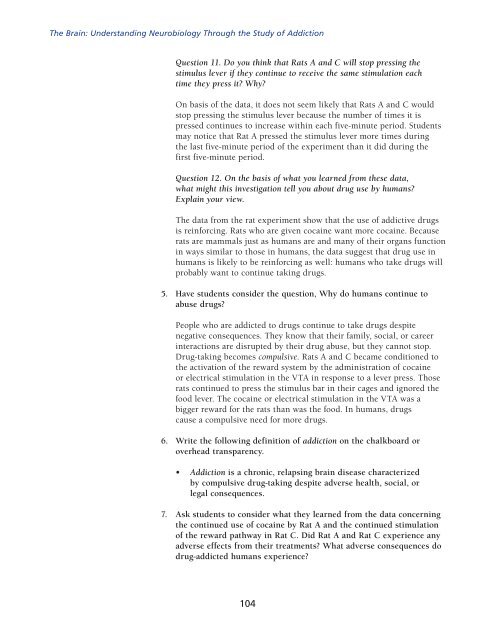Drug Abuse And Addiction - NIH Office of Science Education
Drug Abuse And Addiction - NIH Office of Science Education
Drug Abuse And Addiction - NIH Office of Science Education
You also want an ePaper? Increase the reach of your titles
YUMPU automatically turns print PDFs into web optimized ePapers that Google loves.
The Brain: Understanding Neurobiology Through the Study <strong>of</strong> <strong>Addiction</strong>Question 11. Do you think that Rats A and C will stop pressing thestimu lus lever if they continue to receive the same stimulation eachtime they press it? Why?On basis <strong>of</strong> the data, it does not seem likely that Rats A and C wouldstop pressing the stimulus lever because the number <strong>of</strong> times it ispressed con tinues to increase within each five-minute period. Studentsmay notice that Rat A pressed the stimulus lever more times duringthe last five-minute period <strong>of</strong> the experiment than it did during thefirst five-minute period.Question 12. On the basis <strong>of</strong> what you learned from these data,what might this investigation tell you about drug use by humans?Explain your view.The data from the rat experiment show that the use <strong>of</strong> addictive drugsis reinforcing. Rats who are given cocaine want more cocaine. Becauserats are mammals just as humans are and many <strong>of</strong> their organs functionin ways similar to those in humans, the data suggest that drug use inhumans is likely to be reinforcing as well: humans who take drugs willprobably want to continue taking drugs.5. Have students consider the question, Why do humans continue toabuse drugs?People who are addicted to drugs continue to take drugs despitenegative consequences. They know that their family, social, or careerinteractions are disrupted by their drug abuse, but they cannot stop.<strong>Drug</strong>-taking becomes compulsive. Rats A and C became conditioned tothe activation <strong>of</strong> the reward system by the administration <strong>of</strong> cocaineor electrical stimulation in the VTA in response to a lever press. Thoserats continued to press the stimulus bar in their cages and ignored thefood lever. The cocaine or electrical stimulation in the VTA was abigger reward for the rats than was the food. In humans, drugscause a compulsive need for more drugs.6. Write the following definition <strong>of</strong> addiction on the chalkboard orover head transparency.• <strong>Addiction</strong> is a chronic, relapsing brain disease characterizedby compulsive drug-taking despite adverse health, social, orlegal consequences.7. Ask students to consider what they learned from the data concerningthe continued use <strong>of</strong> cocaine by Rat A and the continued stimulation<strong>of</strong> the reward pathway in Rat C. Did Rat A and Rat C experience anyadverse effects from their treatments? What adverse consequences dodrug-addicted humans experience?104
















